
幼稚園・保育園向けソフト遊具
当社のソフト・プレイ・ソリューションは、幼い学習者のために安全で魅力的な教育的環境を作り出すように設計されています。丈夫な素材と考え抜かれたデザインを組み合わせた当社のソフト・プレイ製品は、活発な遊びを促しながら、身体的・認知的発達を促します。幼稚園、保育所、屋内プレイエリアに最適な、カラフルなプレイマット、カスタムクライミング構造、コーディネーション、バランス、社会的相互作用を促進するインタラクティブな要素などを取り揃えています。どの商品も、スペース独自のニーズに合わせてカスタマイズ可能で、あらゆる年齢のお子さまが楽しく安全に学べる環境をお約束します。
多様なソフト遊具
鮮やかなプレイマットから特注のクライミングストラクチャーまで、楽しさと機能性の両方を考慮してデザインされた製品を取り揃えています。クライミングストラクチャー、すべり台、トンネルなど、ソフトでカラフル、そして耐久性に優れたさまざまな遊び道具からお選びください。お子さまの年齢を問わず、ダイナミックで安全な遊び場をつくるのに最適なソフト遊具を、ぜひご覧ください。

12ピースソフトプレイブロック

ファクトリー ソフトシェイプセット

クォーター・レストフルコーナー

ベビー・ナット&ボルト・クライマー

6ピース・ソフト・プレイ・ブロック

4ピースソフトプレイクライミングセット

ベビー・フォーム・クライミング・ブロック

ソフト・フォーム・ボール・ピット

ツリートンネルとクライマー

ソフト遊具泡虹

クラウド・キャッスル・ビルディング・セット

亀のボールピット
カスタマイズされた幼稚園の家具のメーカーとサプライヤー
幼稚園家具業界で20年以上の経験を持つWinning Kidzは、幼児の発達を促す革新的で高品質な遊びのソリューションを提供する信頼できるブランドです。職人技と安全性へのこだわりにより、すべての製品は、お子様の成長と遊びを支え、安全で魅力的な空間を提供すると同時に、学習環境を向上させるよう設計されています。
当社のソフトプレイ製品は、耐久性があり、お子様に優しい素材を使用し、多くの方が行き交う遊び場の要求にも耐えられるよう設計されています。鮮やかな色のプレイマットから、独創的なクライミング構造物まで、当社のソフトプレイ製品は、身体活動、協調性、そして社会的な交流を促進します。Winning Kidzなら、安全で安心な環境で、お子様が長く楽しく遊び、発達を促すことができるよう、すべての製品が作られています。
環境にやさしい素材の使用から生産方法の最適化まで、私たちは環境への影響を最小限に抑えるよう努めています。プロセスのあらゆる側面にサステナビリティを取り入れることで、子どもたちの成長と発達をサポートするだけでなく、地球の未来にも積極的に貢献する製品を生み出すことを目指しています。

ソフトプレイとは何ですか?
ソフトプレイとは、幼児が柔らかくクッション性のある遊具を使って様々なアクティビティに取り組める、安全で楽しい遊び場を指します。これらのエリアは、管理された環境の中で、身体活動、創造性、そして社会的な交流を促すように設計されています。ソフトプレイ遊具には、柔らかいプレイマット、ボールプール、クライミングブロック、そして子どもたちが探索、学習、そして遊びを楽しむ中で安全を確保する遊具などが含まれます。ソフトプレイは幼児期の発達に不可欠であり、子どもたちの運動能力、協調性、そして問題解決能力の向上に役立ちます。
ソフトプレイの利点
ソフトプレイエリアや遊具には様々な利点があり、幼稚園、保育園、さらには家庭にも欠かせない存在となっています。主な利点は以下のとおりです。
身体の発達を促進する
ソフトプレイは、登ったり、ジャンプしたり、這ったり、バランスを取ったりといった身体活動に子どもたちが積極的に参加することを促します。これらの動きは、運動能力、協調性、筋力の発達を促し、全体的な健康状態の向上にも役立ちます。
社会スキルの向上
ソフトプレイエリアでは、グループでの遊びが促されることが多く、チームワーク、コミュニケーション、そして分かち合いが育まれます。子どもたちは、社会的な環境の中で、他者と交流し、争いを解決し、協力して働く方法を学びます。
認知発達を促進する
ブロック、トンネル、障害物コースなど、多くのソフトな遊び道具は、子どもたちの創造力と問題解決能力を刺激します。これらのアクティビティは、批判的思考力、空間認識力、そして問題解決能力を刺激します。
感覚刺激を与える
柔らかい遊具は、様々な質感、色、形があり、感覚を刺激します。これは、子どもたちの感覚処理能力を発達させ、触覚、視覚、動きを通して好奇心を刺激するのに役立ちます。
安全な探索を奨励
ソフトプレイ環境は安全性を考慮して設計されています。クッション性のある表面が衝撃を吸収し、怪我のリスクを軽減するとともに、子どもたちが安全で管理された環境で自由に探索したり、リスクを冒したりできるようにします。
感情の発達を改善する
ソフトプレイは、登ったりトンネルをくぐったりといった課題を乗り越える際に、子どもたちの自信を育むのに役立ちます。課題をうまく達成することで、子どもたちの自尊心と感情的な回復力が高まり、新しいことに挑戦する意欲が高まります。
ソフト遊具の素材
ソフト遊具は、幼児にとって安全で耐久性があり、快適に遊べるよう、様々な素材で作られています。これらの素材は、身体を保護し、遊びの中で感覚刺激を促すよう、慎重に選ばれています。ソフト遊具に最もよく使われる素材は以下のとおりです。
1.ゴム
- 説明ゴムは衝撃吸収性が高いため、よく使われます。フォームに比べて硬い素材ですが、クッション性を発揮するのに十分な柔らかさも備えています。
- 使用ゴム製のマットや床材は、クライミング構造の下やプレイゾーンの床材など、人の出入りが多い柔らかい遊び場でよく使用されます。
- 利点: 耐久性に優れ、防水性、滑り止め性があり、お手入れも非常に簡単です。
2. PVC(ポリ塩化ビニル)
- 説明PVC は、フォームまたはインフレータブル構造を覆う、硬くて耐久性があり、柔軟なプラスチック素材です。
- 使用PVCは、バウンスハウス、ボールプール、トンネルなどのインフレータブル遊具の外装によく使用されます。また、柔らかいプレイマットやフォームで覆われた滑り台にも使用できます。
- 利点: 防水性があり、お手入れが簡単で、耐摩耗性に優れており、さまざまな色と質感のものが揃っています。
3.ビニール
- 説明ビニールは、強度と柔軟性に優れた合成素材です。PVCに似ていますが、やや柔らかい質感です。
- 使用: ボールプール、滑り台、ソフトプレイトンネルなどのパッド付き表面や膨張式遊具の製造によく使用されます。
- 利点柔らかく、耐久性があり、お手入れも簡単です。ビニールは汚れにも強く、頻繁に使用しても劣化しません。
4. ポリウレタン(PU)フォーム
- 説明: ポリウレタンフォームは、柔らかい遊具によく使われる素材です。標準的なフォームよりも密度が高く、硬さも優れていますが、安全な遊び場を提供します。
- 使用PU フォームは、クライミングフレーム、パッド付きバリア、障害物コースなどの構造物によく使用されます。
- 利点: 耐久性と長寿命性に優れ、大型または重量のある構造物にも優れたサポート力を提供します。PUフォームは難燃性で、高い衝撃にも耐えることができます。
5. Nylon & Polyester Fabrics
- 説明これらの素材は、ソフトプレイ製品のカバーとしてよく使用されます。耐久性と柔軟性を兼ね備えた織物です。
- 使用ナイロンとポリエステルは、フォームブロック、マット、またはインフレータブル遊具の外層によく使用されます。これらの生地は、耐水性とお手入れのしやすさを高めるためにコーティングされていることが多いです。
- 利点軽量でお手入れも簡単で、様々な色と質感の素材を取り揃えており、遊び場を美しく演出します。また、破れやほつれにも強いのが特徴です。
6. フォーム
- 説明フォームは、ソフト遊具で最もよく使われる素材の一つです。軽量でクッション性があり、衝撃を吸収して怪我を防ぎます。
- 使用フォームは、パッド入りマット、クライミングブロック、そして様々な形状の遊び場(キューブ、ウェッジ、ランプなど)によく使われます。柔軟性があり、様々な形にカットできるため、柔らかい遊び場を作るのに非常に汎用性があります。
- 利点: 柔らかく、衝撃を吸収し、お子様にも安全で、丈夫な生地で覆われているのでお手入れも簡単です。
ソフト遊具の種類
ソフト遊具には様々な種類があり、年齢層や遊び環境に合わせて設計されています。一般的な種類としては、以下のようなものがあります。

障害物コース

ソフトプレイマット

トンネル

バウンスハウス

ボールピット

アクティビティテーブル

ソフトプレイブロック

クライミング構造物
適切なソフト遊具の選び方
ソフト遊具を選択するときは、スペースとそれを使用する子供たちにぴったり合うことを確認するために、いくつかの要素を考慮することが重要です。
年齢層と発達ニーズ:ソフト遊具を選ぶ最初のステップは、使用する子どもたちの年齢層を理解することです。年齢層によって、発達のニーズを満たすために求められるデザインや機能は異なります。
安全性と耐久性:ソフト遊具を選ぶ際は、安全性が最優先事項です。選ぶ遊具が国際的な安全基準と規制に準拠していることを必ず確認してください。
スペースとレイアウト:ソフトプレイ機器を選ぶ前に、利用可能なスペースを慎重に測定してください。ソフトプレイエリアは、スペースに収まるだけでなく、動きやすくアクセスしやすいものでなければなりません。
テーマと美的魅力: ソフト遊具の見た目と感触は、子どもたちの遊びへの興味を惹きつける上で同様に重要です。明るい色、面白い形、テーマに沿ったデザインは、遊び場全体の雰囲気を高めることができます。
予算とコスト効率: ソフト遊具を選ぶ際には、予算の制約も考慮する必要があります。高品質な製品に投資することは重要ですが、予算内で購入できるソリューションを見つけることも重要です。
- カスタマイズとデザインの柔軟性: 教育機関ごとにニーズやスペースの制約は異なります。だからこそ、カスタマイズ可能なソフト遊具を提供するサプライヤーを選ぶことは大きなメリットとなります。
ソフトプレイセンター vs 伝統的な遊び場
| 特徴 | モンテッソーリミラー | 伝統的な鏡 |
|---|---|---|
| 安全性 | クッション性のある表面、衝撃を吸収する素材、監督された遊び。 | 表面が硬いため、怪我をするリスクが高く、監視も少ない。 |
| 天候依存 | ほとんどが屋内施設なので、あらゆる天候条件に適しています。 | 屋外設置、天候に左右されます。 |
| 年齢範囲 | 年少のお子様(幼児から未就学児)に適しています。 | 幼児から年長児まで幅広い年齢層に適しています。 |
| 身体活動 | ハイハイ、登り、穏やかな身体遊びを促します。 | 走ったり、ブランコに乗ったり、登ったりするなど、よりアクティブな遊びを促します。 |
| メンテナンス | 洗える素材と表面でメンテナンスが簡単です。 | 天候にさらされるため、より頻繁なメンテナンスが必要になります。 |
| スペース効率 | コンパクトで狭い屋内スペースにも適応します。 | 多くの場合、より大規模な屋外スペースが必要になります。 |
| 監督 | 管理された環境で子供たちを監視しやすくなります。 | 屋外のオープンスペースでは監視が難しくなります。 |
| 発達上の利点 | 運動能力、協調性、感覚遊び、安全な探索に焦点を当てます。 | 体力、バランス、屋外での探索に重点を置きます。 |
| 料金 | 屋内設備の初期設置コストとメンテナンスコストが高くなります。 | セットアップコストは低くなりますが、維持のために継続的な投資が必要になる場合があります。 |
ソフトプレイセンター vs 伝統的な遊び場
ソフトプレイエリアを設置する際には、そのスペースを利用する子どもたちの年齢を考慮することが最も重要な要素の一つです。ソフトプレイエリアは、それぞれの年齢層の発達段階や身体能力に合わせて設計し、すべての子どもが安全に楽しく遊べるようにする必要があります。

幼児向けソフトプレイ(0~2歳)
ソフトプレイエリアは、乳児の基本的な感覚と運動能力の発達に焦点を当てるべきです。この段階では、子どもたちは周囲の環境を探索し、自分の体の動きをコントロールし始めたばかりです。ソフトプレイエリアは、シンプルで安全、そして子どもたちが簡単に触れ合えるものでなければなりません。
推奨機器:
- ソフトマットとクッション柔らかいマットは、赤ちゃんが這ったり、転がったり、探索したりできる安全な空間を提供します。マットは様々な配置で配置でき、赤ちゃんの動きを刺激し、促します。
- 腹ばいパッド: 乳児が頭を持ち上げる練習をし、首と肩の筋肉を強化するために設計されています。
- クロールトンネル軽くて柔らかいトンネルは、赤ちゃんの這いずりを促し、身体活動を促し、協調性と筋力を養います。
- 感覚遊びさまざまな色や模様のある質感のあるクッションや柔らかい遊び用ブロックは、視覚と触覚の発達を刺激します。

幼児向けソフトプレイ(2~4歳)
幼児は協調性、バランス感覚、敏捷性が向上し始めるため、ソフトプレイエリアには、登ったり、ジャンプしたり、基本的な問題解決能力を育む遊具を設置する必要があります。この段階では、幼児はより社会性を身につけ、インタラクティブな遊びを楽しむようになり、認知能力と社会性の発達に役立ちます。
推奨機器:
- クライミング構造物: スロープや小さな丘などの柔らかく低い登り構造物は、幼児に達成感を与えながら、体力と協調性を養うのに役立ちます。
- ミニスライド: 柔らかいパッド入りの素材で作られた滑り台は、幼児が安全を確保しながらバランスと協調性を楽しく練習できる方法です。
- インタラクティブプレイパネルボタン、テクスチャ、色が付いたパネルは幼児の興味を引き、感覚学習と探索を促進します。
- クロールとジャンプエリア幼児がジャンプしたり転がったりできる場所は、運動能力と空間認識力を養うのに最適です。

未就学児向けソフトプレイ(4~6歳)
未就学児は、運動能力、社会性、認知機能が急速に発達します。自信が深まるにつれて、柔らかい遊具は、身体的にも精神的にも挑戦できる、より複雑な構造を持つようになります。この段階では、子どもたちは想像力豊かな遊びに没頭する可能性も高まるため、自由な発想で遊べるデザインを取り入れることが重要です。
推奨機器:
- 障害物コース: スロープ、トンネル、柔らかい障害物を備えたシンプルな障害物コースは、未就学児に戦略的思考を促し、敏捷性、体力、空間認識力を養います。
- クライミングウォール: 低いクッション付きのクライミングウォールや柔らかいクライミング設備は、未就学児の上半身の筋力と協調性を養うのに役立ちます。
- 多層プレイエリア: 複数のレベルがある遊具により、未就学児はさまざまな高さや空間を探索することができ、協調性が向上し、想像力豊かな遊びが促進されます。
- インタラクティブプレイハウスこれらには、トンネル、滑り台、クライミングエリアが組み込まれた柔らかいプレイハウスが含まれ、ごっこ遊びの機会が無限に広がります。

年長児向けソフトプレイ(6歳以上)
子どもが成長するにつれて、身体能力が高まり、より挑戦的な遊びへのニーズが高まります。6歳以上の子どもには、ソフトプレイエリアでより高度な遊具を利用でき、身体能力と認知能力の両方に挑戦することができます。また、この年齢の子どもはより組織的なグループ遊びに参加し始め、社会性の発達にも役立ちます。
推奨機器:
- 高度なクライミング構造: より高いクライミングウォール、はしご、ネットは、より大きな挑戦を提供し、持久力、強さ、問題解決能力を促進します。
- 平均台: 低い平均台は、子供たちが体を動かすことを奨励しながら、安定性と協調性を向上させるのに役立ちます。
- 多目的プレイゾーンこれらのゾーンでは、子供たちは走ったり、ジャンプしたり、這ったりするなどさまざまな活動に従事することができ、敏捷性、柔軟性、創造性を育みます。
- グループプレイエリア: ブランコ、回転ディスク、グループクライミングエリアなどのインタラクティブな要素を備えた広いソフトプレイスペースは、協力的な遊びや社会的スキルを育むことができます。
ソフトプレイセンターの設置ガイドライン
ソフトプレイセンターを設置するには、安全で、楽しく、効率的な空間を確保するために、綿密な計画が必要です。ソフトプレイセンターを設置する際に考慮すべき重要なガイドラインをいくつかご紹介します。
空間計画とレイアウト:
- スペースを最大限に活用するボールプール、ブロック、トンネル、マットなど、様々な種類のソフト遊具を設置できる十分な広さを確保してください。動きやすく、見守りやすいレイアウトにしましょう。
- ゾーニング様々なアクティビティごとに異なるゾーン(例:クライミングゾーン、ハイハイエリア、ボールプールゾーン)を割り当てましょう。これにより、スペースを整理し、子どもたちに様々な遊び体験を提供できます。
安全機能と素材:
- ソフトフローリング怪我のリスクを最小限に抑えるため、センター全体に柔らかいプレイマットまたはクッション性のある床材を設置してください。床材は滑りにくく、衝撃を吸収し、掃除がしやすいものにしてください。
- 安全な機器: フォーム、ビニール、ゴムなど、毒性のない耐久性のある素材で作られた器具を選びましょう。鋭い角を避けるため、すべての器具の角は丸みを帯びていることを確認してください。
- 障壁と門柔らかい遊び場のゲートやフェンスを使って遊び場を区切って、子どもたちが迷子にならないようにしましょう。子どもだけでなく、見守る大人にとってもアクセスしやすい場所に設置しましょう。
適切な監督と人員配置:
- 人材配置: 訓練を受けたスタッフを雇用し、子供たちを監視し、安全な遊び環境を維持します。スタッフには、子供の安全と応急処置に関する知識を十分に備えさせてください。
- 可視性スタッフがソフトプレイセンターのあらゆるエリアを、遠くからでも容易に見渡せるようにしてください。そのためには、オープンスペースや透明な仕切りを戦略的に配置するのが効果的です。
アクセシビリティ:
- 障がいのある子どもも含め、すべての子どもが利用できるように、センターのアクセスを確保してください。特別なニーズを持つ子どもに対応するために、スロープ、幅の広い出入り口、感覚遊具の設置を検討してください。
年齢に適した機器を選択する:
- スペースを利用するお子様の年齢層を考慮してください。柔らかいプレイマット、幼児用ブロック、フォーム製のおもちゃは、低年齢のお子様に最適です。年齢が上のお子様には、滑り台、トンネル、大型のクライミング構造物など、より難易度の高い遊具を用意すると良いでしょう。
- 年齢による分離: 安全を確保するために、幼児用ソフトプレイエリアと子供用ソフトプレイエリアなど、年齢ごとに別々のプレイエリアを設けることを検討してください。
清潔さとメンテナンス:
- お手入れが簡単な素材: 拭き取りやすく消毒しやすいビニールやゴムなどの素材で作られた機器を選択してください。
- 日常清掃: 遊び場を衛生的に保つために、毎日の清掃スケジュールを設定してください。これには、遊具、床、おもちゃの定期的な清掃が含まれます。
- 定期検査: 機器の消耗を定期的に点検し、すべてが安全に機能する状態を維持していることを確認します。
インタラクティブで魅力的なデザイン:
- 楽しい機能: カラフルなソフトプレイ玩具、インタラクティブな壁、テーマ別のプレイエリアなどの要素を追加して、子供たちにとってより魅力的なセンターを作りましょう。
- 想像力豊かな遊びソフトプレイキッチン、ソフトブロック、おもちゃセットなど、創造的な遊びを促す要素を取り入れましょう。これらのアイテムは、遊びながら子どもたちの創造性を育むのに役立ちます。
保護者のための快適な待合室:
- 保護者の方のために、椅子や軽食、そしてプレイエリアが見渡せる快適な待合スペースをご用意ください。これにより、保護者の方はお子様の様子を見ながらリラックスしていただけます。
ソフトプレイエリアの安全上の注意事項
ソフトプレイエリアでは、お子様の安全を確保することが最も重要です。ソフトプレイエリアの設置と維持管理において考慮すべき重要な安全上の注意事項を以下に示します。
-
定期検査 ソフト遊具は、部品の緩み、鋭利な角、破損した素材など、摩耗や損傷がないか定期的に点検する必要があります。毎日点検することで、潜在的な危険を特定し、迅速に対処することができます。
-
明確な安全標識 乱暴な遊び、高所からの飛び降り、遊び場内での適切な行動など、ルールや安全に関するガイドラインを保護者と子どもに分かりやすく伝える標識を設置しましょう。これにより、誰もが安全に遊ぶための期待を認識できるようになります。
-
重量と容量の制限 ソフト遊具は、構造への過負荷を避けるため、重量と収容能力の制限を設ける必要があります。これらの制限を遵守することで、遊具の安定性と安全性が確保されます。
-
子供の行動を監視する 子どもたちには、安全に遊ぶように促し、登り道具以外の遊具に登ったり、押したり、突いたりといった乱暴で危険な行為をしないように促しましょう。優しく、敬意を持って遊ぶことが大切です。
-
避難経路と緊急時の手順 出口が明確に示され、緊急時の避難手順が整備されていることを確認してください。緊急事態が発生した場合、職員と来訪者は出口の位置と安全な避難方法を把握しておく必要があります。
-
清潔さと衛生 細菌やバクテリアの拡散を防ぐには、ソフト遊具の定期的な清掃と消毒が不可欠です。特にフォームブロック、マット、トンネルなど、接触頻度の高いエリアは、表面を頻繁に拭き取ってください。
よくあるご質問
ソフトプレーとは?
ソフト・プレイとは、幼児が探検したり、登ったり、ハイハイしたり、運動能力を発達させたりできるように設計された、安全でクッション性のある遊び環境を指す。発泡スチロール製の構造物、トンネル、滑り台、マット、インタラクティブな要素などがあり、すべて柔らかく衝撃を吸収する素材でできている。
なぜソフトプレーは子どもたちにとって有益なのか?
ソフト・プレイは、安全で管理された環境の中で、身体の発達、感覚の探求、バランス、協調性、社会的交流を促します。また、問題解決、自信形成、創造的な遊びを促進する。
ソフト・プレイは屋外で使用できますか?
はい、一部のソフト遊具は屋外用に設計されており、耐紫外線性、防水性、耐久性に優れた素材を使用しています。屋外の環境に適しているかどうかは、必ず製品の仕様をご確認ください。
ソフト遊具の掃除やメンテナンスはどうすればいいのですか?
毎日、子供にも安全な刺激の少ない消毒剤で表面を拭き、取り外し可能な布製カバーは定期的に洗濯する。業務用セットアップの場合は、週1回または必要に応じてディープクリーニングを行う。
ソフト・プレーは、特別な配慮が必要な子供たちに適していますか?
そう、ソフトプレイは、自閉症やその他の発達障害を持つ子どもたちの感覚療法によく使われる。
自宅にソフトプレイエリアを設置するには?
家庭でソフト・プレイ・エリアを設置するには、まず利用可能なスペースを見極め、安全性を確保するために適切なクッションフロアや発泡マットを選ぶことから始める。次に、ハイハイトンネルや滑り台、発泡スチロールのブロックなど、月齢に合ったソフト遊具を選び、運動と協調性を促します。遊びをより楽しくするために、カラフルで感覚を刺激するようなおもちゃを取り入れ、遊具が清潔に保たれ、手入れが行き届いていることを確認する。最後に、お子さまが安全に楽しみながら遊べるよう、遊具の安全性を定期的にチェックしましょう。
ソフト・プレイはどの年齢層に適していますか?
ソフト・プレイは通常、生後6ヶ月から6歳までの子供を対象として設計されているが、大型の遊具ではそれ以上の年齢の子供も遊べるものもある。特定のプレイエリアや遊具の推奨年齢を必ず確認してください。
ソフトプレーはカスタマイズできますか?
そう、ソフトプレイエリアは、特定のニーズや好みに合わせてカスタマイズできるのです。多くの業者がカスタマイズ可能なソフト遊具を提供しており、スペースや使用する子どもの年齢に最適なサイズ、色、デザイン、遊具の種類を選ぶことができます。発泡ブロック、トンネル、滑り台、クライミング構造など、さまざまな要素から選ぶことができ、形や数、質感などの教育的な特徴を取り入れることもできます。カスタマイズすることで、ソフト・プレイ・エリアが安全基準を満たすだけでなく、ご自宅や施設の美的・機能的な要件も満たすことができます。

